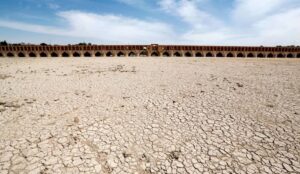‘Day Zero’ looms as Islamic Republic faces complete shortage
Iran’s economy is in a mess. The rial is now in free fall.
When Khomeini came to power in 1979, there were 42,000 rials to the dollar. Now the exchange rate is 882,000 rials to the dollar.
Thirty percent of Iranians now live below the poverty line. Some analysts claim up to 80% of Iranians live in poverty.
Because of American sanctions that have caused the traditional buyers of Iranian oil to go elsewhere, Iran is forced to sell its oil at a steep discount to the handful of new buyers who have replaced them.
And Iran is currently experiencing a major water crisis, the greatest in its history.

Iran is currently experiencing a major water crisis. The Iranian government has declared an emergency public holiday in Tehran Province as the nation grapples with a severe water shortage and energy crisis, compounded by soaring temperatures that have pushed the country’s aging infrastructure to its breaking point….
As the temperatures soar, water use soars. Plants need more irrigation, as water evaporates more quickly. Consumers use more water to beat the heat in public pools, private baths and private showers.
They consume more energy to run air conditioning, but the energy provided by hydroelectric dams decreases as the waterways on which the dams depend have dried up dramatically.
And in addition to the record-breaking heat in Iran, there is a long-lasting drought. Tehran Province, which includes the capital, has been most affected; it is now enduring its fifth consecutive drought in as many years.
The alarm bells have been ringing for years, and the data is increasingly grim. Water reserves in Tehran’s five main reservoirs have plummeted to 13 percent of their capacity. The Lar dam, a vital source for the capital, is nearly empty, only 1 percent full. Three other dams hold between 6 percent and 12 percent of their capacity.
This dramatic depletion reflects a lack of rainfall as well as mismanaged use. Nineteen provinces are experiencing significant drought, with Hormozgan, Iran’s southernmost province, reporting a staggering 77 percent decrease in average rainfall, followed by Sistan and Baluchestan in the southeast with a 72 percent drop.
Key water sources such as the Shamil and Nian dams in the Persian Gulf port of Bandar Abbas, Esteghlal dam near the city of Minab in Hormozgan province, and the Zayandehrood river, the largest in the central Iranian plateau, are also facing drastically reduced reserves.
The Deputy Minister of Energy, Mohammad Javanbakht, has described the current water year as one of the most challenging in Iran’s history, reporting a 45 percent decrease in average rainfall. To mitigate the crisis, he has called for a 20 percent reduction in water consumption, but it is difficult to see how this can be enforced….
You can call on the population to reduce their use of water, but there is no way to enforce such a request. What has happened is a series of shutdowns of water supplied to homes, as well as increases in the cost of water, leading to widespread popular distress and anger at the government, that is naturally wary of an increasingly hostile population.
The water crisis in Iran is not solely attributable to natural causes. It is a complex issue driven by climate change, mismanagement of water resources, population growth and urbanization, as well as over-extraction of groundwater.
By mismanagement is meant a failure to introduce new methods of irrigation — such as Israel’s drip irrigation — that use less water for the same effect on plants. It refers to the failure to repair or replace leaky pipes all over the country.
It refers to the practice of extracting too much groundwater, as an easy “fix” during an aboveground drought. The practice, however, has many unfortunate consequences.
Excessive pumping can lower the groundwater table, and cause existing wells to no longer be able to reach groundwater.
Land can subside when there is overuse of groundwater. The soil can collapse. In addition, if groundwater is depleted, there can be a deterioration in the quality of water. In coastal areas, when groundwater is pumped out, salt water can seep in to replace it, resulting in saltwater contamination of the water supply.
The Iranians have relied much too heavily on groundwater rather than replacing pipes, instituting drip irrigation, and employing recent technological advances, such as Israel’s WaterGen, that produces water from the ambient air.
PHOTO and VIDEO: Use according to Section 27 A